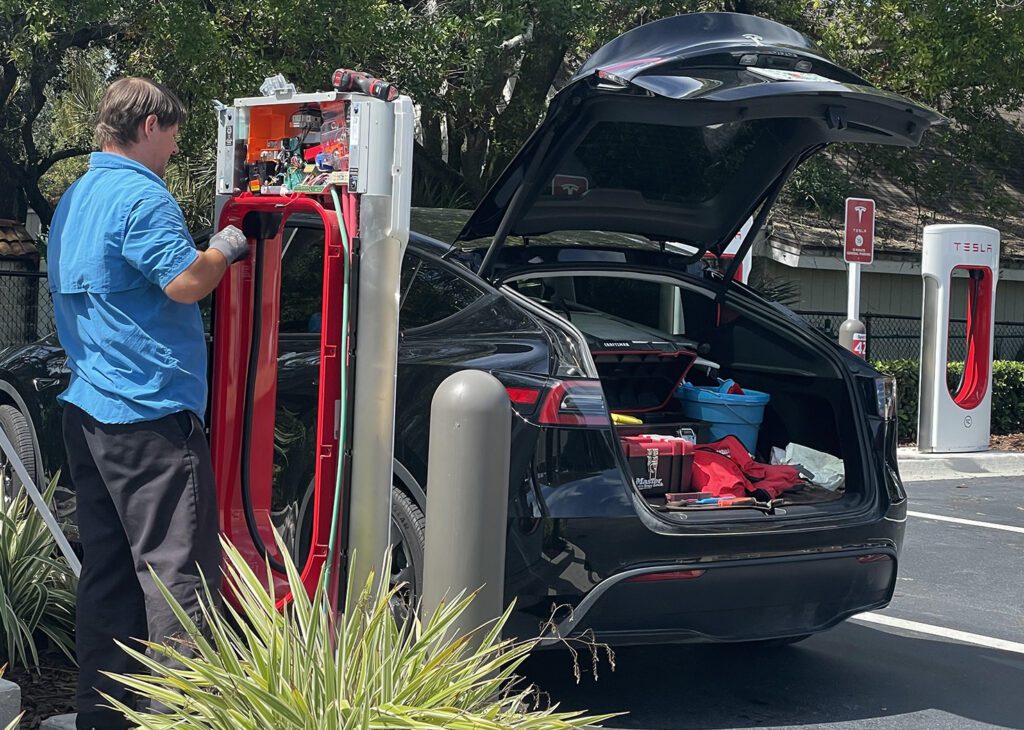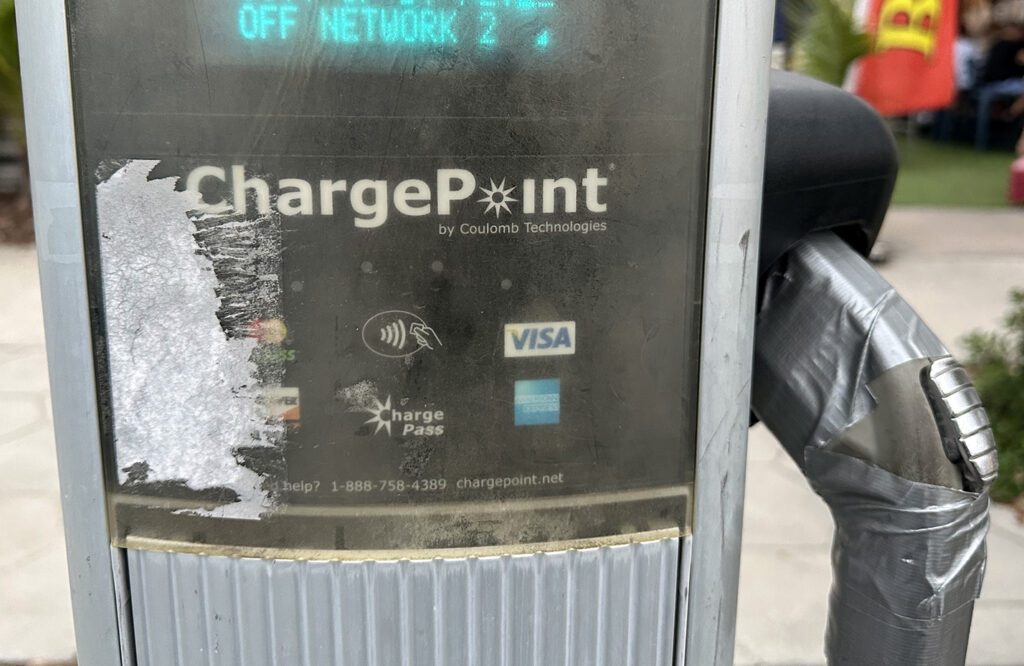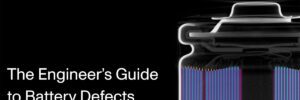
- Public EV charging sessions fail as much as 25% to 30% of the time, according to a group of industry stakeholders convened by SAE, and the reasons are not particularly well known.
- Currently, there is no industry-wide standard to categorize, log, report or analyze charging errors and common causes of failure.
- SAE, the oldest and largest technical society for engineers in the automotive field, is working to develop standards for EV charging error codes, and helping to build a curriculum to train the technicians to repair and maintain equipment.
Q&A with Frank Menchaca, President of SAE International’s Sustainable Mobility Solutions
The reliability—or rather, the unreliability—of public EV charging stations is nothing less than a scandal, and it’s holding back EV adoption. This tragedy involves a cast of many players—automakers, charger manufacturers, network operators, electric utilities, and often a lot more—and all need to start reading from the same script if there’s to be any hope of a happy ending.
The industry badly needs technical standards to enable charging providers to document, diagnose and repair charging problems in a uniform way. So, it’s encouraging to see that SAE International, the most prominent standards body in the automotive field, is wading into the fray. SAE has established a new business unit called Sustainable Mobility Solutions to “help lead industries to a net-zero emissions future for transportation.”
As one of its first initiatives, Sustainable Mobility Solutions has published “Electric Vehicle Charging Data Performance & Reporting,” a detailed study of charging failures and a set of proposals for evaluating those failures and finding solutions. SAE calls the new study “the most comprehensive technical review of EV charging system performance, data reporting and reliability to date.”
SAE has also partnered with a company called ChargerHelp! to help recruit and train the workers that will be needed to repair and maintain the rapidly growing network of EV-related hardware and software. The partnership will place a special emphasis on recruiting people from disadvantaged communities, traditional automotive mechanics, and workers making the transition from declining industries such as nuclear, coal and oil.
Charged spoke with Frank Menchaca, a long-time SAE executive and the President of the new Sustainable Mobility Solutions unit.
SAE was founded in 1905 by Henry Ford and merged in 1915 with the Society of Aeronautic Engineers under the suggestion of Orville Wright.
Charged: Public charger uptime is a huge issue—everybody’s up in arms about it. For those who may not be familiar with SAE, tell us why the organization is equipped to deliver the engineering expertise and organize the industry cooperation that’s going to be needed to solve this complex problem.
Frank Menchaca: SAE is the oldest and largest technical society for engineers in the aerospace, commercial vehicle and automotive areas, founded in 1905 by Henry Ford and merged in 1915 with the Society of Aeronautic Engineers under the suggestion of Orville Wright.
If you’ve ever put a child safety seat into a car or exited an airplane or gotten a delivery by a truck, you’ve interacted with us. We are the organization that creates standards for the industry on things like that and about 45,000 other things. We also have a robust training business where we educate engineers, and we have an information publishing business. Maybe our biggest attribute is that we’re a convener—we bring industry together with government and other stakeholders to advance the industry.
I incubated our work in sustainability. We decided that so much was happening in this area that we really needed to dedicate a special unit [Sustainable Mobility Solutions], and that’s what I lead. We’re kind of like a startup within a 120-year-old organization. Our mission is to discover, incubate, and develop initiatives that lead to net zero transportation. We move very quickly. We identify a set of challenges in the market, and we ascertain how we’re going to help to solve those. The reliability project is a good example of that.

About a year ago, we convened a group of organizations including Tesla, Rivian, Toyota, ChargePoint, Electrify America, Lucid, FLO, the Department of Energy, the National Renewable Energy Lab, a few others, and we said, “We think that we have a role to play in charging infrastructure, but we want you to tell us where you think we can add value.”
The group was very quick in pointing out this question of charging reliability. Public charging fails about 25% to 30% of the time. The reasons for it are not particularly well known, interestingly enough. There’s a whole nexus of things that come together in charging. There’s what happens between the vehicle and the charger, there’s communication between the vehicle and the OEM, the utilities and so forth. So, when something fails, you get a lot of error codes, but those error codes are not categorized. They’re not named consistently, there’s no standard ontology, and there’s not really a standard practice for analyzing failure.
When something fails, you get a lot of error codes, but those error codes are not categorized. They’re not named consistently, there’s no standard ontology, and there’s not really a standard practice for analyzing failure.
As a result, it’s very hard to benchmark where you are and to actually improve. These companies said, “We want you to take this on.” So, a subset of those companies brought their charging data together, and we analyzed it and ran some diagnostics on it, and we kind of used the 80/20 rule. We said, “Where does charging fail 80% of the time? Let’s figure those out. Let’s categorize them. Let’s give them a name.”
We documented it, we created an ontology, we created a procedure for analyzing failures, and that is the substance of this 50-page technical report that we put out [Charging System Performance Reporting]. And we’re continuing that dialogue with the joint office of the Department of Transportation and Department of Energy. We’ve shared it with them. We think that there’s an opportunity to expand this work and really create a framework for reliability. The US government is going to spend about $7.5 billion on charging infrastructure, so we think it’s a good idea to have a reliability target that you can benchmark and that you can report on and feed back to industry.
The US government is going to spend about $7.5 billion on charging infrastructure, so we think it’s a good idea to have a reliability target that you can benchmark and that you can report on and feed back to industry.
Charged: So, have you figured out why those darn things break so often?
Frank Menchaca: We isolated about five different causes. Sometimes it has to do with plug removal—the user is not sure the plug is in. Sometimes the charging system is not communicating with the vehicle. Another major area is payment, because there are many, many different payment methods, and sometimes the payment just doesn’t go through. And then a lot of times there is damage to the station.
Part of our protocol calls for recording the exact geographic coordinates of the charging station because it may be underperforming or not performing due to weather or flooding. And as we head into periods of more extreme weather, those charging stations are exposed to higher heat or more water than is typical.

Charged: It occurs to me that some of the problems may be caused by the fact that so many different companies touch these things. For some public chargers, there may literally be a dozen organizations involved. Does the SAE have a role in trying to establish some standards so the different companies are not all doing different things?
Frank Menchaca: Yeah, we do. And it goes back to charging reliability. That’s based on a data reporting protocol. Every company can do things according to what gives them a competitive advantage, but we should report the data in a standard way so that we have a common understanding of how things are performing. We can say, “This charging station is performing better because of X, Y and Z,” and that’s great, but our means of measuring performance shouldn’t be different. The performance can be different, but our means of measuring it should be the same.
Every company can do things according to what gives them a competitive advantage, but we should report the data in a standard way so that we have a common understanding of how things are performing.
Charged: Obviously, SAE has been dealing with new technologies for a long time. So, the problems we’re seeing with EV charging reliability, does this sound like normal growing pains for a new technology?
Frank Menchaca: I think the scale of what’s happening is a big factor. This is the largest infrastructure project in the United States since the [construction of the Interstate Highway System], and we’re trying to do this in a very short period of time. Imagine the gas station: How long did it take for that entire infrastructure—the delivery of the gas and all of that—to get set up? Decades and decades. We are trying to do something similar in a much more compressed period of time.
Maybe that’s the anomaly, that’s what’s different. We’re needing to invent the infrastructure, the protocols that stand behind it, the way to service it, all at the same time.
Charged: You mentioned establishing standards for error codes. Are there some other standards you might look at establishing in the EV charging field?
Frank Menchaca: We’re establishing frameworks that can then be iterated on and developed into standards. Reliability is one area. Lifecycle assessment is the other area. We think that the battery lifecycle has to be mapped out and framed. Lifecycle assessments are very complex activities where you try to understand the footprint and emissions associated with a product—you have to work back through the entire value chain and understand how all of these different systems come together to create a product.
We’re establishing frameworks that can then be iterated on and developed into standards. Reliability is one area. Lifecycle assessment is the other area.
In this case, the product is batteries. It starts with natural resource extraction. What are the steps that go into that? And then how are those transported? How are they manufactured? How is the battery pack designed and created? How is it installed and used? And then what happens when it’s used up? Do you put it into a second life? Do you recycle it? That’s another big area where we’re creating frameworks that we think will be the starting point for standards.
The thing to understand about this area is that it’s dynamic. It’s happening as we speak. Our average standard creation time is something like two years, and by the time you’ve spent two years creating a standard, a lot of times the technology moves on. So what we’re doing is creating frameworks in a relatively short period of time, intellectual and scientific structures for understanding something and benchmarking it. Those things will later become standards. That’s what we did with reliability, and that’s what we’re doing in the area of battery lifecycle.
Charged: Well, you just touched on a couple of topics that we could probably talk about for hours, because battery traceability is a huge topic too.
Frank Menchaca: Yeah. We’re involved in that. There was a workshop last week for the EU battery passport that we were involved in. It’s no longer enough just to engineer the battery. You have to document chemical components, how it was manufactured, so that the next time that battery is going to be touched or used, everybody knows how it was put together and you can repurpose it or recycle it and so forth. It’s a super-important area.
A big component of that is not only documenting the technical environment or the intersection of technical systems, but also training people how to operate in this area. For example, we are creating a professional certification around charging station service where we say, “Here are the skills you need to have to go and service a charging station,” and then we’ll certify you. We’re working with a company called ChargerHelp! that does that.
A big component of that is not only documenting the technical environment or the intersection of technical systems, but also training people how to operate in this area.
We also recently announced our partnership with a company called InnoEnergy to bring in a set of battery curricula, about 30 battery courses, because the US particularly is somewhat behind in this area, and we want to start manufacturing batteries here, so we’ve got to train people to do that.
Charged: As far as jobs in charging equipment repair, do you have any figures on how many techs will be needed? What would you say to somebody thinking of that as a career?
Frank Menchaca: Our certification plan calls for at least 2,000 to 3,000 in the next 12 months, and then it just ramps up from there. ChargerHelp! is our partner in this area. They’re a women- and minority-run business based in Los Angeles, and they are successful in recruiting people who are not normally included in clean tech jobs. What they’re saying is, “You can learn how to do this. This is an expanding field, and it can become a career. You can learn how to be a field technician, but you can also begin to understand the hardware and software components of EV charging equipment.”
Our certification plan calls for at least 2,000 to 3,000 in the next 12 months, and then it just ramps up from there.
Charged: Obviously you work closely with government agencies in the US and Europe, and that’s all very pertinent because the EU’s got their battery directive, and we’ve got our IRA and BIL. What about China? Do they use your standards over there too?
Frank Menchaca: Not all of our standards are used worldwide, but we do have an office in Shanghai, and we work collaboratively with that office and the companies in that area to try to understand what we can learn from them, because they tend to be a little bit further ahead than everybody else.
In some ways, China is, I think, quite forward in this area. I remember having a conversation with an engineer at one of the major private Chinese companies, and he said, “We’re producing electric cars without the battery because the government is actually taking on the creation of the battery. You get your car, you get a battery, and you swap it out when it gets to a certain point. Government takes care of recycling it, repurposing it, feeding it back to the grid.” I think this is a very interesting way of thinking about the future, and I think China is in a lot of ways, maybe in the vanguard at the moment.
Charged: There’s a new charging standard for heavy-duty EVs, the Megawatt Charging System, or MCS. Is that something that SAE was involved with?
Frank Menchaca: We have our own megawatt charging initiative. We were not involved in the MCS, but we’re all about interoperability. We think it’s really important that everything that gets created in this infrastructure is interoperable, and we’re working along with other standards organizations to create that, and to harmonize what we’re doing.
Charged: Are different standards organizations competitors, or do they cooperate?
Frank Menchaca: It’s a little bit of both. There’s that phrase coopetition, and I think that’s probably a good way of describing it. Ultimately, we exist for the good of society, and it is in society’s interest to have harmonization and interoperability. We do work with other standards organizations, there’s no question about that, and we decide how we’re going to work together. And SAE has an affiliate company called the Industry Technologies Consortium, which actually allows us to convene companies to do just that, to collaborate in a way that helps industry, helps society.
Charged: What do you think about Tesla opening up the design of their charge plug? People were talking about a standards war, but all Tesla did was make the actual plug design public, right?
Frank Menchaca: We have relationships with Tesla. We know them well, they work with us. I think that they are interested in creating interoperability. This is one way of doing it, and they’ve been market leaders. They’ve been out there for a long time with not only their vehicles, but the entire infrastructure. I think the more we can work together, the more we can collaborate and understand how we build off of each other’s work, the faster this work will be done.
As someone once put it to me, Tesla never really wanted to get into the charging station business, but they had to because there was no other alternative. So I think they blazed a trail and now they’re willing to share the trail with other people.
Charged: Looking forward at some of the new trends in the EV world, do you see other areas in which we’re going to need new standards?
Frank Menchaca: Yeah. It’s great that electric vehicles have zero tailpipe emissions, but that electricity needs to be sourced in a sustainable way, so we want to make sure that we are designing for use of renewable energy in that electricity creation. We need standards and practices that speak to that circular economy—how do you design around reuse? Not like fossil fuels which you burn.
I think that’s going to be a big area for us to tackle—how do you design for continual use, for really long life with a product? Everyone I know that’s engaged in batteries and electric vehicle infrastructure is thinking about this. That’s what I see on the horizon.
How long have internal combustion engine vehicles been around? 120-plus years. So, it’s arguable that we don’t have all the practices or vocabulary required for us to think about reuse. How do you design for reuse? How do you plan for it? And then in your manufacturing processes, how do you take something and put it to another use? As one company said to us, “If we create a product that ends up creating a pile of batteries that has to be dealt with, that’s probably not a good thing.” Instead, we should plan from the beginning to design for reuse, second life, and ultimately recycling.
from Charged EVs https://ift.tt/FaP8AjI



No comments:
Post a Comment